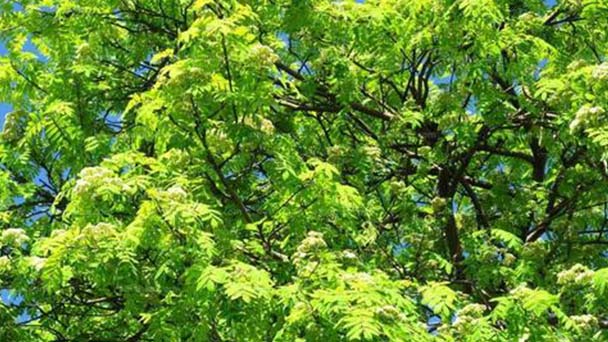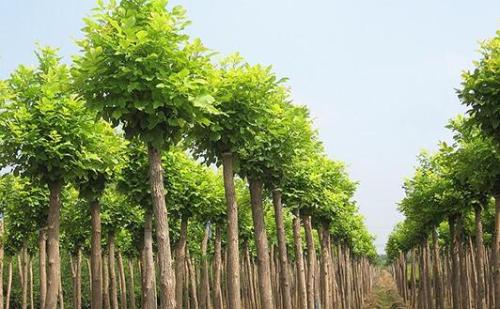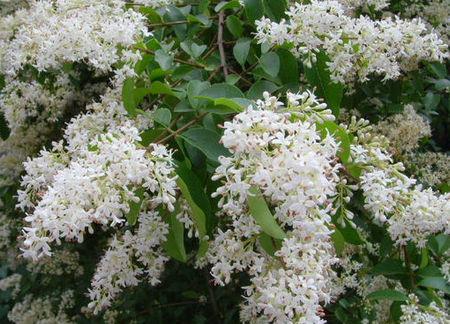Chinese ash (Fraxinus chinensis) profile
Written by Maggie
Mar 26 2021

Chinese Ash (Fraxinus chinensis Roxb) is a deciduous tree of the family Luteoceridae, with grayish-brown, longitudinally split bark. Bud is broadly ovate or conical, brown pubescent or glandular hairy. Branchlets are yellow-brown, coarse, glabrous or sparsely pubescent, soon bald, lenticels small, inconspicuous. Terminal leaflets are subequal to lateral leaflets or slightly larger, apex acute to acuminate, base obtuse or cuneate, leaf margin evenly serrate, glabrous above, glabrous below or sometimes white pubescent on both sides along midrib, midrib flat above, persistent calyx appressed to base of nut, often opening deeply parted on one side.
Chinese ash is mostly cultivated, and chinese ash has a long history of cultivation and is widely distributed. Chinese ash is also found at an altitude of 800-1600 m mountain forest. Plant germination force is strong, the material is straight, the growth is rapid, soft and tough, for the preparation of various appliances; Bark is also used medicinally.
Chinese ash picture

Morphological characteristics of Chinese ash
Chinese ash is a deciduous tree, 10-12 m tall; Bark is grayish brown, longitudinal split. Bud is broadly ovate or conical, brown pubescent or glandular hairy. Branchlets are yellow-brown, coarse, glabrous or sparsely pubescent, soon bald, lenticels small, inconspicuous.
Pinnately compound leaves of Chinese ash are 15-25 cm long; Petiole is 4-6 cm long, base not thickened; Leaf axis is straight, mask shallow trench, sparsely pubescent at first, then bald net; Chinese ash has 5-7 lobules, hard paper, ovate, oblong to lanceolate, oval 3-10 cm long and 2-4 cm wide, apical lobule and lateral lobule nearly as large or larger, apex sharp pointed to acuminate, base obtuse or cuneate, margin regular blade, glabrous above, glabrous or sometimes under the long white pilose on both sides along the midrib, midrib in the flat above, lateral veins 8-10 on, raised below, fine veins in two sides convex, obvious net knot; Petioles of Chinese ash are 3-5 mm long.
Panicles of Chinese ash are terminal or axillary branch tips, 8-10 cm long; Pedicels are 2 -- 4 cm long, glabrous or pilose, smooth, lenticellata; Flowers are dioecious; Male flowers are dense, calyx small, campanulate, ca. 1 mm long, corolla absent, anthers and filaments subequal; Female flowers are scattered, calyx large, barrel-shaped, 2-3 mm long, 4-lobed, style slender, stigma 2-lobed.
Samara of Chinese ash is spatulates, 3-4 cm long and 4-6 mm wide, widest in the upper middle, apex acute, often plowshare shaped, tapering at the base, wings spreading downward to the middle of the nut, nut cylindrical, ca. 1.5 cm long; Persistent calyx appressed to the base of the nut, often opening deeply parted on one side.
Ecological habits of Chinese ash
Chinese Ash is a positive tree species, which likes light and has strong adaptability to soil. It can grow in acid soil, neutral soil and calcareous soil. It is tolerant to mild salinity and alkali, and likes moist, fertile, sandy and loamy soil. Chinese ash was born at an altitude of 800-1600 meters in mountain forest.
Distribution region of Chinese ash
Chinese ash is produced in the provinces and regions of north and south China. Most of them are cultivated.Vietnam, North Korea also have distribution. Chinese Ash was introduced into India, Japan, Europe and the United States by the late 18th century at the latest.
The propagation of Chinese ash
Sowing
Spring sowing should be early, generally in spring sowing. The amount of seed is 3-4 kg per 667 m2, the depth is 4 cm, the depth is uniform, with the furrow, with the sowing, with the soil, with the soil thickness of 2-3 cm.In order to make the soil closely connected, after covering the soil suppression.
Cutting seedlings
In spring, cutting before careful preparation, the application of sufficient base fertilizer, so that the soil loose, adequate moisture. The 1-year-old budding branches are selected from the robust young mother trees with rapid growth and no diseases and insect pests. The branches are generally more than 1 cm thick and 15-20 cm long. The upper cut is cut flat and the lower cut is horse ear shaped. Insert 2-3 pieces into each hole, so that cuttings are scattered, row spacing is 40 cm, plant spacing is 20 cm, spring insert should be buried deep, solid, less outcrop, insert 4000 plants every 667 square meters.

Disease control of Chinese ash
Insect pests
Chinese Ash is vulnerable to ash, aphids, longicorn beetles, etc. Chinese Ash sprout before the sprout of sulphur mixture, every 10 days 1 times, two consecutive spray, in order to kill overwintering germs. During the disease stage, 800-1000 times of 50% carbendazim or 800-1000 times of 70% methyl thiocendazim were mixed with any one kind of insecticide (such as 1000 times of 20% cypermethrin emulsion or 1500 times of 5% cypermethrin emulsion) to carry out tree trunk coating to prevent and control Chinese ash gum disease.
Disease
Leaf spot
Symptoms: Brown spot mainly harms the leaves of Chinese Ash, causing early defoliation and affecting the growth of trees in the current year.
Pathogenesis: The pathogen of the brown spot is parasitic on the front of the leaf, with scattered polygonal or nearly round brown spots. The center of the spots is graying brown. The diameter of the spots is 1-2 meters, and the serious spots are 5-8 meters.The front of the spot is covered with brown mildew spots, namely the fruiting body of the pathogen.
Prevention and control methods: Seedling should be timely thinning, early strengthen fertilizer and water management, enhance the disease resistance of seedlings.Pay attention to nutrition balance, not partial application of nitrogen fertilizer.In autumn, the diseased leaves left on the ground of the seedbed should be swept up and processed centrally, buried deep on the spot or burned remotely to reduce the source of overwintering bacteria. In summer, 1∶2∶200 times of Bordeaux liquid or 65% mancozeb wettable powder 600 times liquid was sprayed 2-3 times, and the disease prevention effect was good.
Coal sludge disease
Symptoms: Coal stain is mainly caused by insect pests such as ash aphid, scale insect and whitefly. In addition to damaging leaves, it also harms ash branches, blocking leaves' stomata and impeding normal photosynthesis. In addition to causing early defoliation of ash, it focuses on affecting the annual growth of seedlings.
Occurrence rule: the pathogen of coal stain overwintering in the form of mycelium or mucomyst on disinfected leaves and spots. Because the mucus secreted by aphids and scale insects provides nourishment for the pathogen of coal smudge, it is common for coal smudge to occur in large numbers after the occurrence of these two pests.Spring and autumn are the flourishing period of coal pollution disease.
Prevention and control methods: through thinning seedlings, pruning and other measures, so that the tree ventilation and light, enhance the tree potential, and improve the resistance of Chinese ash. Timely prevention and control of aphids, scale insects, mealworms, etc., can be used imidacloprid or acetamiprid, at the same time mixed with carbendazim or methyl tobutin, can effectively prevent and control the occurrence of diseases. Scale insect is a kind of pest that is difficult to control. It is necessary to seize the peak of nymphal activity and use the drug. It can be used to kill the scale with 800-1000 times of liquid.
Uses of Chinese ash
Environmental protection
Chinese Ash has lush branches and leaves, developed roots, strong plant germination, rapid growth and resistance to moisture and barren drought. It can also grow in mild salt-alkali land, and is an excellent tree species for windbreak and sand consolidation and road protection.
Watch
Chinese ash, its dry shape straight, beautiful tree shape, anti-smoke dust, sulfur dioxide and chlorine gas, is a good plant for factory, urban greening and beautification.
Economic
The wood of Chinese ash is tough and can be used to make all kinds of utensils. It can also be used to make furniture, farm tools, vehicles, plywood, etc. The branches can be woven into baskets.

Latest Updated
- Benefits of Bugleweed - 7 Science-backed Health Benefits
- Bugleweed Dangers & Side Effects - Is It Poisonous?
- How to Plant Evergreen Trees - What You Should Know
- When to Plant Evergreens - Grow Guide for Evergreen Trees
- 12 Wonderful Evergreen Shrubs for Your Garden
- 12 Popular Evergreen Plants with Pictures for Beginners
- When And How To Prune A Lilac Bush Like a Pro
- How to Grow & Care for Lilac Vine (Hardenbergia Violacea)
- Japanese Lilac Tree (Syringa Reticulata) Care & Propagation Guide
- Shumard Oak Pros and Cons - What to Know
Popular Articles
- Winter maintenance of Antirrhinum Majus
- How to Grow Terminalia Mantaly Tree
- How to Grow and Care for Crossostephium Chinense
- How to grow Antirrhinum Majus in spring
- Peristeria Elata (Dove Orchid) Profile: Info & Care Guide
- Underwatered Snake Plant (Sansevieria Trifasciata) - Signs And How To Fix
- How to Care for Brazilian Jasmine Plant (Mandevilla Sanderi)
- How to Grow & Care for Graptopetalum Purple Delight in Summer
- Rosa Chinensis (China Rose): Plant Growing & Care Tips
- How to Care for Baby Sun Rose (Aptenia Cordifolia)